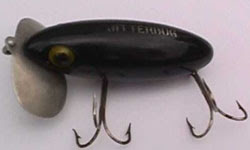Okay, here’s the scenario. You’re at a large outdoors retailer with your fourteen year-old son, and he points at a $150 baitcaster and asks, “Dad, can I have that for Christmas?” This could evolve into your worst fishing nightmare. Imagine a beginner’s fist time out with a spinning reel and multiply it by ten. Casting reels are notorious for bird nesting; this occurs any time the line comes off of the spool faster than the lure or bait is going through the air. For the novice, this can be every other cast!
There are ways of keeping this problem in check. After putting line on the reel, place it on a rod and run the line through the eyes. Then tie a weight (1/2 oz. sinker for example) on the end of the line and let it drop. Optimally, the weight should slowly drop to the ground. If it hangs there, it won’t cast. If it freefalls, watch out for the bird’s nests! This adjustment can be made with the drag knob. Here’s another small piece of advice. STOP the lure or bait before it hits the water. That’s done by putting your thumb on the roller. Many line problems occur with overcastting, but more often than not, it’s the sudden stop that makes the mess.
It may sound like I dislike baitcasters, but this is not true. They are everyday equipment for professional fishermen, and there has to be a reason. What other type of reel will hold 140 yards of 12 lb. test and cast this heavy line half the length of a football field? None. This is because of a “free flowing” spool. On spinning and spin casting reels, the line flows off in a more awkward, sideways angle. Many baitcasters have high speed gears and have a 7:1 retrieval ratio, and the crank has a more direct link to the spool than spinning or spin casting reels. This results in optimum power for fighting big fish.
Baitcasting reels come in a wide variety of prices and quality. On the low end, there is the Cabela’s All Pro Casting Reel for $29.99, and on the high end the Shimano Calcutta runs $499.99. Reels are like anything else: you get what you pay for, and fortunately there are happy mediums. The Abu Garcia Revo SX-L runs approximately $129 and has many of the features of higher priced reels. A final consideration is reel type. There are two styles of baitcasting reels, round and low profile. The round style allows the fisherman to “palm” the reel, which is a popular technique, and the low profile is sleeker, shaped almost like an “inverted teardrop.”
Like any other piece of fishing equipment, there is a baitcaster for all levels of fishermen, and might I suggest that you give the reel many tries before depositing it in the dumpster in a fit of rage.
Quick Facts about Baitcasting Reels:
-They are not recommended for novice fisherman
-Price range is between $30-$500
-Fisherman who use bait and are trying for large fish typically opt for baitcasting reels
Labels: Abu Garcia, baitcasters, baitcasting reels, shimano reels








